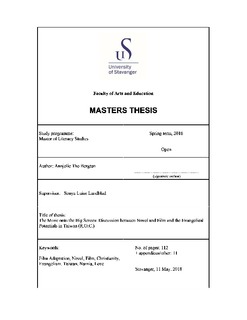| dc.description.abstract | The following thesis uses the 2005 film: The Chronicles of Narnia: the Lion, the Witch and the Wardrobe as main text in the Case Study section to analyse the process of adaptation with measurements mainly provided by scholar Brian McFarlane in the field of film adaptation. McFarlane emphasises on what he terms as ‘fidelity,’ determining if the film has been adapted faithfully to its source novel. The present thesis also contains a secondary focus on how the Narnia film has evangelical potentials, specifically in Taiwan. The first chapter offers an introduction and explains the claim in slightly more detail along with the research questions behind the purpose of the present thesis. Then, Chapter Two provides a number of different scholars’ theories in the field of film adaptation as it is the primary focus of the present thesis to help understand the transition of the story from paper to screen later on in the case study section. The last section of Chapter Two contains literature review on the secondary focus on the evangelical aspect.
Centring on McFarlane’s fidelity criterion, the claim of the present thesis is that fidelity is salient in the case of Narnia’s adapted film –given that the story is created with a Christian theme of love in terms of affection, friendship and charity –in order for the film to be used as an evangelical tool. To prove that the importance that fidelity (faithful to the spirit) must be kept (see pp. 10) and considering the Narnia story contains a central message of love in Christianity, 20 churches in Taiwan are surveyed to find out whether or not the Narnia film has been used as an evangelical tool in the non-Christian island of Taiwan (see pp. 109-112). The survey discovers whether or not the film has acted as an evangelical medium that leads to successful conversion. Relevant and various theories are presented in the last section of the second chapter. The third chapter provides a thorough analysis regarding the Narnia story in the novel and in the adapted film, first in a mechanical word-by-word comparison before moving to the thematic analysis regarding love. As the elements in each form are different, adjustments are applied when deemed necessary by the director. The result shows that in spite of the novel and film being two very different formats, the film does manage to maintain the theme of love.
For the reason that Taiwan has a strongly non-Christian-related background, a section with information regarding the main religion that forms the basis of many, if not all, (national) celebratory holidays, is provided. As contrast with Christian ‘unconditional love,’ as demonstrated in the Narnia story, the information provided in this section shows a mandate of conditional reciprocation with the gods starting from life and ending after death. In other words, worship in exchange for blessings and protections. After the religious background is briefed, the data from the survey of 20 churches are presented, during which three points are presented: 1.) the Narnia film has been used as an evangelical tool in Taiwan, 2.) conversions happen because of the evangelical event and 3. the film proves to be faith-strengthening to the Christians.
After all the information is provided and analysed, a discussion is provided in Chapter Six, leading to the conclusion in Chapter Seven, confirming fidelity is important in the case of 2005 film The Chronicles of Narnia: the Lion, the Witch and the Wardrobe for the evangelical usage in the folk-religion-based island of Taiwan, Republic of China. | nb_NO |

